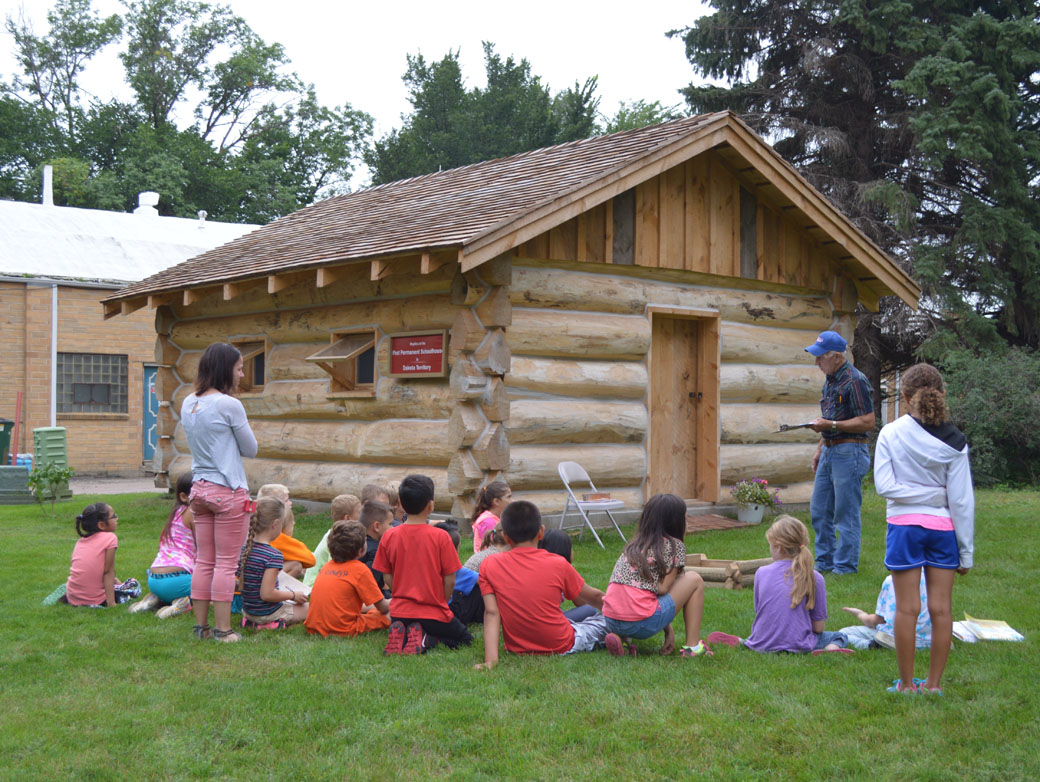
Replica of historic schoolhouse returned to Vermillion
At long last, a replica of the first schoolhouse built in Dakota Territory has come to reside at the Austin-Whittemore House in Vermillion, where officials hope it will set the stage for education in the region and provide an opportunity for University of South Dakota students and others to broaden their horizons.
A dedication ceremony for the replica held Sept. 3 drew a crowd of more than 70 people, where the Clay County Historical Society (CCHS) honored the nearly 150-year-old structure and its history, recognizing the efforts needed to finally get the replica built after years of debate.
Dan Christopherson, former mayor of Vermillion and former president of CCHS, was one of the grand masters of the project.
“It’s important to preserve history, and this is the history of education of this region,” Christopherson said. “It’s important to try and teach our young people where their roots came from, what it was really like to attend a one-room schoolhouse.”
Christopherson said the schoolhouse doesn’t just represent Vermillion’s history, but the history of the Midwest, especially Dakota Territory.
“When you think about the expanse of the geographic area, it’s almost beyond what you can think about,” he said.
The ceremony took place just in time to celebrate the 150th anniversary of the original building and the 75th anniversary of the first replica.
The original schoolhouse was built in 1864 at the base of what is now called Dakota Street Hill. At the dedication, crowds gathered at the Austin-Whittemore House to celebrate the new landmark with a ribbon cutting and program taking place in the early evening.
Area history of the schoolhouse
According to information from CCHS, Captain Nelson Miner of Division A, First Dakota Cavalry, recognized the need for education in the newly-settled area of Vermillion. Miner, his soldiers and some civilians built the schoolhouse out of cottonwood trees logged on the banks of the Missouri River and completed the main structure within a day. They soon added a mud thatch roof and furnished the school.
In 1871, a larger school was built a short distance away. The original school was destroyed, along with much of Vermillion itself, by the Great Flood of 1881. With the help of W.H. Over and many other community members, the first replica was built in 1939 and was placed on several locations at the University of South Dakota throughout the years until 1964. That year, it was moved back to its original location at the bottom of Dakota Street.
Beginning around 2001, CCHS and the Clay County Historic Preservation Commission tried a number of times to restart preservation efforts on the building, which had been neglected and vandalized. They also wanted to move the school onto either the USD campus or the Austin-Whittemore property, but were turned down due to land preservation concerns by the government.
In 2013, the efforts were finally put into action.
After a survey of the replica, it was deemed too far gone to save and the building had to be demolished earlier this year. Only some of the furnishings were salvaged. Talks about a new replica then began.
Hawkins Construction of Vermillion was hired to construct the new replica, which was built from cottonwood logs similar to those used in the original building. Old construction techniques were used as well to preserve the feel of the times.
Overall, the members of the project said they are proud of the outcome of their efforts.
“We’re really happy to have been a part of it and that we’re finally able to make it happen,” Christopherson said. “I think we’re going to be able to keep it for a long time. (We) should be able to preserve it for hopefully 150 more years.”
Bringing it home
Among those present in the audience were at least four descendants of Nelson, including Jane Miner, of Watertown, and Jim Miner, of Yankton.
Jack Marsh, retired president of the Al Neuharth Media Center, was the master of ceremonies.
“We honor the first successful champions of formal public education in a vast frontier,” Marsh said. “Know now those visionaries would be pleased and proud that public education remains a hallmark of this community, home to the state’s flagship university and to an outstanding school system.”
Mayor Jack Powell delivered a proclamation issued by the City of Vermillion, and Ted Muenster recited another proclamation from Gov. Dennis Daugaard.
“Education is extremely important to our state and our nation, and recognizing the beginning of formal education in our state is significant to our history and heritage,” Muenster read.
Historical context of the time period surrounding the schoolhouse’s early days was given by Kurt Hackemer, chair of the History Department at USD. Hackemer placed particular emphasis on the importance of education during the tumultuous Civil War era.
“For early residents of Vermillion, it’s particularly important because they live in an extraordinarily turbulent time,” Hackemer said. “I hope that when you walk through the schoolhouse what you see is more than a simple log structure, as it represents the hopes that our forefathers had for the future of their territory and nation, and it does so in a way that we can learn from and copy in our own time.”
(Jim Stone, a member of the Clay County Historical Society, shows the third grade class from Jolley Elementary the second replica of the first permeant school house in Dakota Territory Wednesday morning before a dedication ceremony. Megan Street/The Volante)

